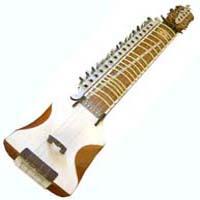
DILRUBA
The Taus, a failrly large and heavy instrument, was designed and created by the tenth Sikh Guru, Gobind Singh. The Sikhs approached Guru Gobind Singh and suggested that its size and weight can create a prob lem in mobility for the Saint-Warriors. Upon request the Guru gave the Sikhs permission to scale down the size and design of the taus. The resulting instrument came in the shape of what is now known as the dilruba (a Persian word meaning ‘heart stealer’).
Early instruments were decorated with gildwork and the gaj bore two or three tassles, usually red or green, on one or both ends. These instruments have a subtle, majestic look.
The dilruba is one of the most popular stringed instruments in the North of India and, like the taus, is a clever combination of the sitar and the sarangi. The fingerboard with the frets very much resembles the sitar. The belly of the instrument is covered with skin like a Sarangi and, like the Sarangi and Taus, it is played with a bow (gaj). The main difference from the Taus is the lack of the artistic peacock head and design of the body.
The stem of the dilruba contains eighteen or nineteen elliptical frets which are movable. They are tied to the stem by means of thin pieces of gut so that the frets can be moved according to the scale of the raga being played. The bridge is placed on the skin-covered body, over which all the main and sympathetic strings pass. Of the four main strings, the last is the principal playing string. There are about twenty-two sympathetic strings or tarabs running underneath the frets and fastened to a series of pegs on the side.
The bowing is done with the right hand while the fingers of the left hand are used to play over the strings. The frets on the dilruba are meant only to guide the player in locating the correct position of the notes. The dilruba is held vertically, the lower portion on the lap of the performer or in front of him and the top resting against the left shoulder.
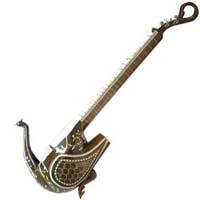
Taus
Taus means ‘peacock’ in Persian and is derived from sitar and sarangi. It’s body is shaped like a peacock and it is played with a bow. It has a sound hole at the ‘tail’ portion of the instrument and stands on bird-feet carved in wood.
Guru Gobind Singh Ji, the tenth Guru of Sikhs, kept the family trend by creating the instrument which he named the ‘taus’, which, in Persian, means peacock. Some scholars believe that the sitar was invented in Guru Gobind Singh’s time period as well, and that the creation of new instruments was in fashion at that time. The taus is painted in all of the bright shades of the beautiful bird, the peacock, in its sound structure. Its long tail serves the purpose of the finger board of the instrument, upon which nineteen metal frets, elliptical in shape, are tied with cotton or silken cord. The lower portion, the head, carved to look just like the peacock, is covered with hide. The taus is played seated, with a bow. The parts of the bow include a wooden round stick, bow hair of horse tail, a wooden bridge, and a screw. The taus has sixteen sympathetic metal strings, along with its four playing strings.
The taus is very similar to the dilruba in construction and in playing technique. However, the taus has a bigger sound box and therefore produces a much more resonant and mellow sound.
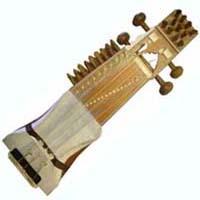
Sarangi
The name Sarangi is said to mean ‘sau rang’ (100 colours) or ‘sa rang’ (colours whatever it touches). It is the most important bowed instrument of North Indian music.
Like most stringed instruments the sarangi has a wooden sound box. The instrument has no frets or fingerboard; the strings float in the air. Pitch is determined by sliding the fingernail against the string rather than pressing it against a fingerboard (like violin). This allows subtle glides and embellishments, which are extremely close to the human voice.
The Sarangi of the Sikhs was brought in and promoted by the sixth Guru, Hargobind Sahib, to sing the ballads from Siri Guru Granth Sahib or from Bhai Guru Das’ poetry. Vaaran (ballads) are to be found in great number among these works, and they incorporate an aggressive approach to singing and expression (an attack on the mind).
It appears that the Sarangi was a folk instrument long before it came to be accepted in classical music as an accompanying instrument. This was most probably during the rise of the Khayal gayaki (style) at the time of Mohammed Shah ‘Rangila’. By the nineteenth century, the Sarangi came to be associated with dancing girls and courtesans, and was used as the standard instrument for accompanying Khayal, Thumri, and occasionally for Dhrupad. However, its popularity is on the decline, partly because of these negative associations, and partly because of the technical difficulties in tuning and playing the instrument.
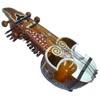
Saranda
Guru Arjan Dev (1563-1606), fifth Sikh Guru, was a master musician and musicologist. He had a great passion for folk music, and looking at his contribution to the musical heritage of India, we see a huge line up which is influenced by folk traditions.
The Saranda took birth from his passion for music. However, there are varying statements and opinions by scholars as to who actually created th e Saranda. Some say it was the idea of Guru Angad Dev Ji and was developed by Guru Ramdas Sahib, the fourth Guru. Examining the facts concerning that time period, and the musical interests related to that period, it makes more sense to believe that Guru Arjan Dev ji invented, or developed, the Saranda. He is said to have designed the Saranda (a large bowl-shaped string instrument, played with bow), which he himself played and used as the ideal accompaniment for the male voice.
The Saranda produces a hauntingly beautiful deep tone quality which sings in alternation and in support of the human voice.
Other instruments:

Pakhawaj
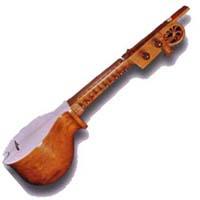
Rabaab
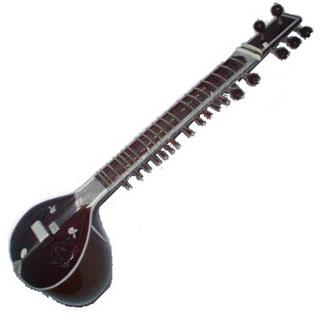
Sitar
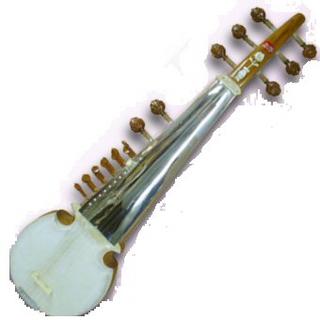
Sarode
Other instruments include: Santoor, Tabla, Tanpura
No comments:
Post a Comment